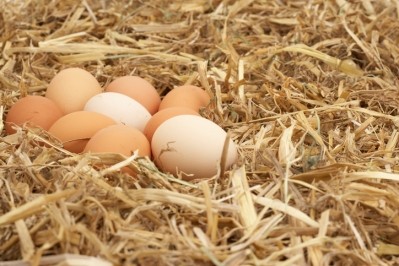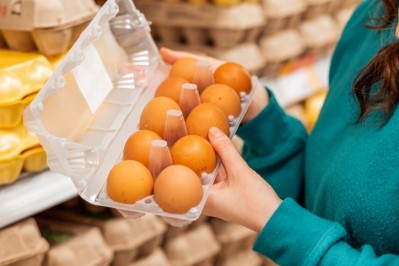Egg prices surge even as inflation slows across the board, including for groceries

The Bureau of Labor Statistics reported Jan. 12 that overall inflation fell 0.1% in December from November – marking the first time in a year that the month-over-month change moved below zero and continuing a downward trend that began in October when inflation increased 0.4% followed by a 0.1% increase in November. These are dramatically lower than the peak month-over-month increase of 1.3% in June.
This translates to a year-over-year increase of 6.5% for all items in December – the smallest 12-month increase since October 2021, according to the Labor Department.
The price of food continues to rise faster than overall inflation, but also is trending downward with a 0.3% increase in December for all food (and 0.2% for food at home) following a 0.5% month-over-month increase in November.
For the full year, food at home is up 11.8% -- driven primarily by a 7.7% increase in the price of meat, poultry, fish and eggs and a 15.3% increase in dairy and related products, the Labor Department reports.
A closer look at inflation across grocery segments reveals a mixed bag with the price of some items falling (such as bacon, which dropped 3.7% yoy in December), but most rising in the single digits or high teens.
One standout, however, is eggs, the price for which increased a walloping 59.5% for the full year – far higher than most other foods with salad dressing coming in the closest at 43.8% for the year. This translates to a dozen eggs averaging $4.16 across all channels, regions and types, according to data insights from IRI – a 46% increase from 2021 and a flabbergasting 74% increase from 2019 before the pandemic began.
Demand should ease with winter holidays over
The steady increase in the price of eggs, and the dramatic spike in the past month, can be attributed to a combination of seasonal demand, higher input costs and tighter supplies due to ongoing fallout from the most recent bird flu outbreak.
December marks one of the “peak demand times” for eggs, which are “so integral to the holidays and pertaining to baking, cooking for your friends and loved ones, and that really drives demand,” which “of course, market conditions always reflect,” Emily Metz, president and CEO of the American Egg Board, told FoodNavigator-USA.
She added with the holidays behind us, “there’s a hopefulness that those conditions will normalize.”
Any normalization due to demand may just be temporary, though, notes Christine McCracken, senior animal protein analyst with RaboResearch. She explained: “The spring holidays are only a few months away and will likely drive another surge in prices.”
Prices may drop, but only slightly and not for long
But even if peak demand drops in January, Metz acknowledges prices may still remain elevated – albeit not as much – as farmers continue to navigate higher input costs due to inflation.
“Fuel is up, feed is up, packaging costs are up. All of that is factored into where we are as well,” she said.
On that front, farmers should be seeing some relief as energy prices continued to fall in December -- dropping 4.5% from November after a 1.6% drop the month before. The price of gas has fallen even more – declining 9.4% over the month following a 2% drop in November, according to the Labor Department. Natural gas and electricity, however, are up 3% and 1%, respectively, in December.
Given the volatile nature of energy prices, any drop in prices likely will not immediately be reflected in that of food consumed at home or ingredient prices given many farmers and manufacturers continue to hedge and could still be experiencing lag from price increases.
Avian flu hit egg laying hens ‘especially hard’
While demand for eggs may even out in the coming months, supplies likely will remain tight in the first half of 2023 as farmers continue to grapple the fallout from “persistent outbreaks” of avian flu in 2022, research analysts from Rabobank note in the recently published report Global Animal Protein Outlook 2023.
“Highly pathogenetic avian influenza is hitting the egg laying and turkey sectors especially hard. More total birds across all poultry segments have been lost now than during the 2015 outbreak,” Lance Zimmerman, RaboResearch senior animal protein analyst, told FoodNavigator-USA.
On a plus note, he added, the supply losses of egg layers and turkeys through spring and summer of 2022 were “less noticed.”
Current outbreaks aren’t as bad as previously
Seeking to reassure CPG companies, retailers and consumers, Metz said the avian flu in 2021 (which continued to impact the population in 2022) was not as bad as 2015 and the recovery has been much faster thanks to hard lessons learned doing the previous outbreak.
“I personally think that they’ve been overstating the impact of bird flu on prices,” she said, noting that “on any given day we have about 320 million laying hens in the population. Right now we are down about 17 million laying hens, give or take, which is roughly about 5 or 6%.”
She added that the 2021 and 2015 outbreaks were “vastly different” in that many farmers were taken aback by the extent and impact of the flu in 2015 but have since made “huge, huge capital investments” to minimize future impacts.
Lessons learned from 2015 speed recovery, ease constraints
This includes new facilities, new biosecurity measures, requirements to “shower in and shower out” when engaging with the flocks and enhanced employee training, Metz said, adding that many farms also invested in “mechanisms to discourage migratory birds from flying over or landing on their properties, which is of course how bird flu is spread.”
Farmers also have sped recovery time based on lessons learned from the 2015 outbreak, when Metz said it took upwards of nine months to repopulate their barns and have birds laying eggs again.
“When you look at 2021, we had farms recovering safely, effectively and efficiently within three to six months. And so that means that really has helped us mitigate the scale and scope of this outbreak. And that that all points to farmers’ investments in understanding this virus and being prepared for it,” she said.
As such, she added, manufacturers and consumers should feel confident that egg supplies will “remain strong and they are still able to get eggs.”
Should manufacturers reformulate without eggs to reduce costs?
Metz also cautioned against manufacturers taking drastic action, such as reformulating with egg alternatives, to offset higher prices. She noted that in 2015 many manufacturers explored this option but found the trade off was a longer ingredient deck which turned off consumers seeking “clean” options, and subpar performance.
“Obviously, I am bias, but the egg is kind of the original Swiss Army knife. It does it all. If you need binding, if you need frosting, if you need leavening, if you need unctuousness – if you need all of those things when you’re manufacturing” eggs deliver, she said.
She added: “Customers experienced when they try to reformulate without eggs is they end up having big performance issues in their product is so our goal as an industry and as the American Egg Board has really been to work with those customers to help figure out you know, different solutions that still use the egg because again, the egg is the original kind of superfood, and can achieve all those outcomes they're hoping for in a product with a clean label and with one singular ingredient.”








